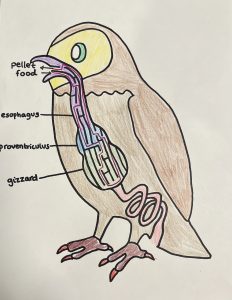50 Working “What Happens to the bones when owls eat mice?”
Owls, diets and regurgitation
What happens to the bones when owls eat mice?
Created by E Banks, E Yeager, and H Burling; members of the University of Minnesota veterinary class of 2027
Learning question and unit goals
This activity is designed to help students explore species differences in anatomy, starting with birds. It should spark interest in the world around them and help students realize that animals have different mechanisms of coping with the inedible parts of their food. Secondarily, this activity should help students develop computer manipulative skills.
Intended grade level
Grades 2-3, connected to life science units
Minnesota science state standard connections
4.1.1 Students will be able to engage in argument from evidence for the explanations the students construct, defend and revise their interpretations when presented with new evidence, critically evaluate the scientific arguments of others, and present counterarguments
3L.4.1.1.1 Construct an argument about strategies animals use to survive. (P: 7, CC: 2, CI: LS2)
4.2.1 Students will be able to read and interpret multiple sources to obtain information, evaluate the merit and validity of claims and design solutions, and communicate information, ideas, and evidence in a variety of formats.
3L.4.2.1.1 Obtain information from various types of media to support an argument that plants and animals have internal and external structures that function to support survival, growth, behavior, and reproduction.** (P: 8, CC: 4, CI: LS1)
Student learning objectives
Students will be able to compare and contrast owl GI anatomy and human GI anatomy through the use of videos, coloring sheets, and multimedia.
Students will be able to describe owl internal structures and how they function to support growth and survival.
Background material
Students should be familiar with basic human anatomy.
Key terms: Esophagus, stomach, digestion.
Lesson format
This activity is expected to take 30-45 minutes. It can be done in the classroom, with students working individually or in pairs.
Outline
Start by asking students questions about their favorite food and how they eat it.
“How they would eat a tough piece of meat?”
“How would you eat a head of broccoli?”
“What tools would you use?”
If students are not sure, you can point to your teeth. Have students discuss which teeth they use to bite food. Which teeth they use to break food up (grind the food). You can talk about how we chew food to help break it up for our stomachs to digest it easier.Remind students how we digest food.
Then you can ask if any students have cats.
“What happens when they eat too much of their own fur?” (Students may mime it out, otherwise you may mention how cats throw up hairballs).
“Okay let’s silently think, why do cats throw up their fur?” (Because they cannot digest it, so they have to expel it in another way.)
Then have students raise hands and answer the question. You don’t need to tell them the right answer yet, this is to get them thinking.
Next, ask students if they have seen owls. Show students pictures of owl mouths.
“What are some differences you notice between an owl’s mouth and your mouth?”
“Do they have teeth? How do you think they grind up their food?”
Again you don’t need the right answer yet. (Eventually students should be able to answer that owls have organs that grind up the food much like how we do with our teeth)
Part 1. Students will watch a 5 minute video on owl digestion, followed by a coloring activity that helps them compare owl and human digestive tracts.
Here is an example of a filled-out maze.

Part 2. Students will watch the dissection of a play doh owl pellet followed by an interactive online dissection.
Optional play doh dissection: Wrap play doh around small objects that might or might not be eaten by an owl. Have students sort the items into piles of what might be realistic and what isn’t. Older students could research owl diets as a supplementary activity.
Assessment
Students will be able to correctly answer questions posed in class by the end of the lesson describing how the owl cannot digest certain things and that is why it regurgitates them.
Students should color code the esophagus and stomach the same as the owl’s esophagus and proventriculus.
Resources
Crayons or colored pencils
Print outs of these documents:
Access to the internet for part 2.
Optional- owl pellets for dissection, dissection supplies OR play doh dissection mockup.

